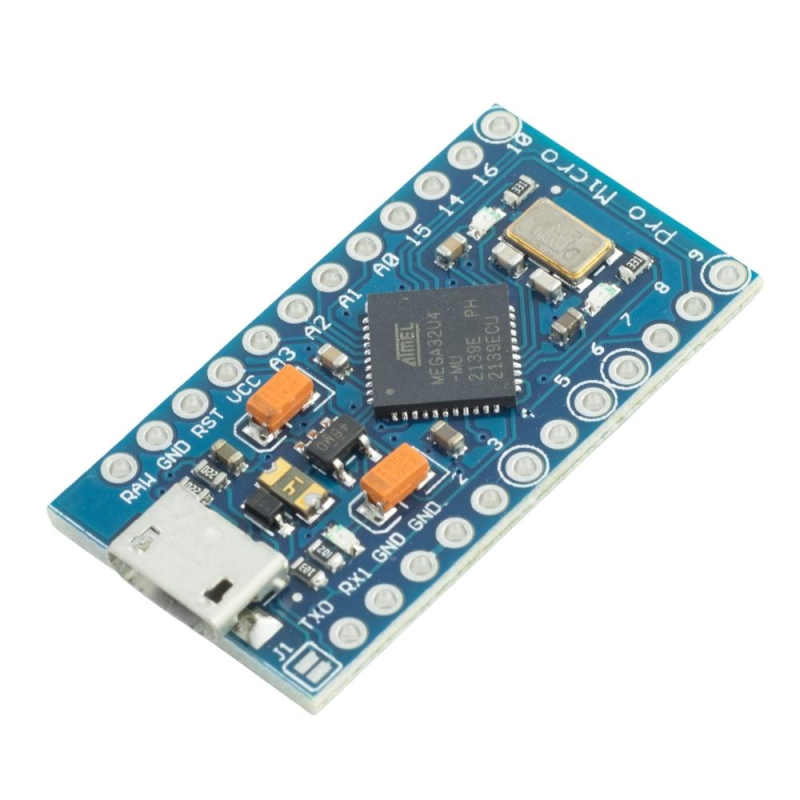



zł43.78 tax excl.
Compact microcontroller board with an ATmega32U4 chip that integrates with USB to act as a HID device such as a keyboard or mouse. It operates at 5V at 16MHz, offering 20 digital I/O lines, of which 7 support PWM and 12 act as analog inputs.
Miniature microcontroller board based on the ATmega32U4 chip, offering full USB integration, allowing it to function as a HID device such as a keyboard or mouse. It is an ideal solution for projects requiring compact size and advanced functionality. The board operates at 5 V, clocked at 16 MHz, and has 20 digital I/O lines, of which 7 can be used as PWM outputs and 12 as analog inputs.
Data sheet
Manufacturer BTC Korporacja sp. z o. o. Lwowska 5 05-120 Legionowo Poland sprzedaz@kamami.pl 22 767 36 20
Responsible person BTC Korporacja sp. z o. o. Lwowska 5 05-120 Legionowo Poland sprzedaz@kamami.pl 22 767 36 20
Board with ATmega2560 microcontroller (256 kB Flash, 8 kB RAM, 4 kB EEPROM) clocked at 16 MHz. USB-UART converter based on the ATmega16u2 chip. The user has at his disposal, among others: 54 I/O lines, 14 PWM channels, 16 analog inputs.
No product available!
Equipped with an equivalent Atmel ATmega328 microcontroller from the AVR family, the board offers 14 I/O lines, 6 PWM channels, and 6 analog inputs. An additional chip communicates via the USB interface
A compact board similar to Seeeduino V4.2/Arduino UNO and fully compatible with Arduino Nano. It uses a USB Type C connector and a Grove I2C connector. Seeed Studio 102010268
No product available!
Board compatible with Arduino Nano. It is based on the ATmega328P microcontroller with 32 KB Flash, 2 KB SRAM and 1 KB EEPROM. It has 12 LEDs, a buzzer and a user button. Cytron Maker Nano
Board with Atmel ATmega328 microcontroller from the AVR family, there are 14 I / O lines, 6 PWM channels and 6 analog inputs. The additional ATmega16U4 microcontroller realizes communication via the USB interface
Microcontroller board based on the ATmega32u4
Virtual keyboard module in the form of a small flash drive. It allows you to simulate the keyboard after uploading the appropriate software and pressing a combination of buttons on the computer.
No product available!
Small evaluation board based on the ATmega328, RoHS
A miniature development board with ATtiny85 microcontroller, on which 6 I / O pins were derived. The module is supported by Arduino IDE. modATT85
Module with ATmega328 microcontroller from the AVR family (32 kB Flash, 2 kB SRAM, 1 kB EEPROM). The module has 14 I/O lines, 6 PWM channels, 8 analog inputs
No product available!
The board is equipped with ATSAMD21 microcontroller with ARM Cortex-M0 core. It has connectors and dimensions compatible with the Arduino Uno Rev3. HW-819
Board compatible with Arduino, equipped with the ATmega32U4 microcontroller
No product available!
Microcontroller board based on Leaf Maple, STM32F103RB, USB, RoHS
Development board with ATmega328P microcontroller compatible with Arduino Uno Rev3. Waveshare R3 PLUS
The board is compatible with Arduino, based on the ATmega328P microcontroller from the AVR family, 14 I/O lines, 6 PWM channels, 6 analog inputs are available to the user. The CH340G chip communicates via a USB interface. In addition, it has 12 LEDs, a programmable button and a embedded buzzer. Cytron Uno Maker
Development board with SAMD21G18 microcontroller. It offers operating frequency up to 48 MHz, 256kB FLASH memory and 32kB SRAM.
No product available!

Compact microcontroller board with an ATmega32U4 chip that integrates with USB to act as a HID device such as a keyboard or mouse. It operates at 5V at 16MHz, offering 20 digital I/O lines, of which 7 support PWM and 12 act as analog inputs.
